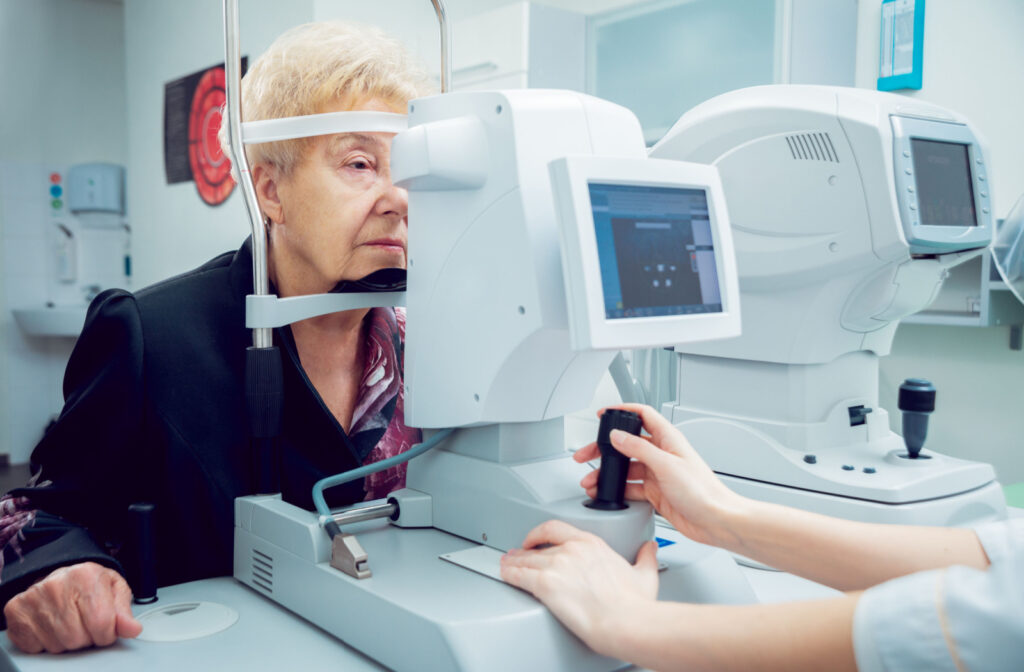With modern technology improving every day, it’s becoming easier and easier to monitor a person’s optical health during a comprehensive eye exam. One of these new advancements is a machine called the OCT—optical coherence tomography, used to provide an OCT vision exam.
OCT is a machine that allows optometrists to monitor your retinal health in a noninvasive way by using light waves to create detailed 3D images of your retina. This gives them vital information on subtle changes that may be occurring in your eye, allowing your eye doctor to detect potentially developing conditions during your OCT vision exam early, and begin appropriate treatment.
What Is an OCT Eye Scan?
OCT stands for optical coherence tomography, which is a noninvasive imaging technique used to capture high-resolution cross-sectional images of your eye and retina. The machine used for OCT scans uses certain light waves to create an extremely detailed image of the different layers of your eye, the OCT vision exam allows an optometrist to monitor subtle changes that may be occurring.
This gives them a chance to detect any potential changes that may be occurring in your eye, which can give an opportunity to begin treatment earlier than normal. By creating an in-depth 3D image of your eye, an eye care professional can help maintain your optical health.
This machine functions similarly to an ultrasound, but rather than sound waves, it uses light waves. These are emitted and sent toward the back of your eye before being reflected back into the machine, where they’re then measured and used to create a 3D image.
What Is an OCT Eye Scan For?
During an OCT vision exam, the OCT eye scan targets the retina. This is the light-sensitive tissue located at the back of your eye. By capturing a detailed image of the retina, the OCT scan allows an optometrist to assess how thick it is, how healthy its overall structure is, and identify potential abnormalities that may need to be addressed.
It can also help check the overall health of your optic nerve itself, which connects the eye to the brain and helps with communication between the two. The OCT scan can determine if there is any damage to the optic nerve, which is often associated with optical conditions like glaucoma. By providing specific measurements and other information about the structure of your optic nerve, the OCT scan can help in the early stages of certain eye conditions.
What Can an OCT Scan Detect?
Because this machine provides such detailed information regarding the health of your eye, it can provide valuable insights into the progression of many optical conditions. For example, this machine is extremely useful when diagnosing:
- Age-related macular degeneration, which is the natural degeneration of the part of the retina that is responsible for sharp and clear central vision
- Glaucoma, which is a group of eye conditions that cause damage to the optic nerve
- Diabetic retinopathy, a common eye condition closely linked with diabetes that can lead to long-term vision problems and damaged blood vessels in the eye
- Retinal detachment, where the retina detaches or shifts from its natural position, which can lead to long-term vision problems
There are many eye conditions that can develop without showing many symptoms, and an OCT vision exam allows an optometrist to scan for many of them. This can help improve your quality of life and help you maintain clear vision for a long time.
What to Expect From an OCT Eye Scan
When visiting your optometrist for an OCT vision exam, you can expect a noninvasive and straightforward experience. This procedure requires no injections, incisions, or anesthetic, which makes it an excellent choice for people looking for a simple but comprehensive scan of their eyes.
Typically, an optometrist will administer dilating eye drops to enlarge your pupils, which allows more light to enter and gives the doctor a better view of the retina and optic nerve. This process may cause temporary blurriness and light sensitivity, but this goes away quickly.
Once your pupils are properly dilated, you will be positioned in front of the OCT machine. You will need to place your chin on a chin rest and lean your forward on a support bar so your head will be stable while the scan is performed. The technician will then guide you to focus your eyes on a specific target so the scan can begin. This process is completely painless and only takes a few minutes.
After the OCT eye scan is complete through an OCT vision exam, the eye care professional will review the captured images and discuss their findings with you. They can explain any concerns that you or they may have, allowing you both to discuss any potentially developing conditions or irregularities and build a treatment plan together to maintain proper eye health.

Eye Care in Alcona, Ontario
At Alcona Eye Care, we know how important it is to keep your vision clear. Our team of trained eye doctors and technicians are here to help you keep your eyes healthy. With access to modern tools like the OCT eye scan, you can rest easy knowing you’re in good hands. To speak with a caring, experienced professional member of our team and receive a comprehensive eye exam, schedule an appointment with us today!




